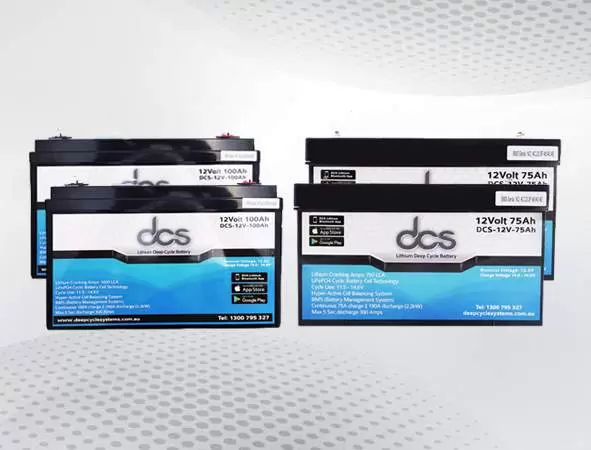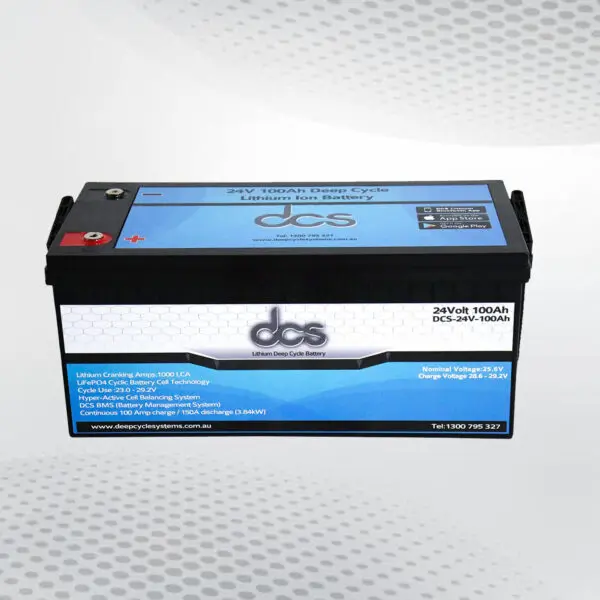Deep-cycle batteries are a valuable tool in many of our everyday technologies. From powering our boats to storing solar energy, they play a significant role in the functionality of many systems. This blog post aims to look closer at deep cycle batteries‘ functionality, mechanism, types, care and maintenance, applications, advantages, and charging methods.
Understanding the Basics of Deep-Cycle Batteries
Deep-cycle batteries are specially designed to be discharged down to a significant portion of their maximum capacity, contrasting with the shallow discharges typical of other battery types. They derive their name from their ability to be repeatedly “deep cycled” or discharged using most of their capacity. This distinguishes them from automotive or starting batteries that deliver a high burst of energy for a short period and are not designed for deep discharge.
In deep-cycle batteries, the energy release is slow and steady, sustaining for a long duration. This capacity to be deeply discharged without significant loss of life expectancy, combined with their ability to recover after such discharge cycles, makes them a preferred choice for applications that require sustained power over long periods. The main components of a deep-cycle battery are:
- The active material (lead dioxide on the positive plate and sponge lead on the negative plate).
- An electrolyte (a solution of sulfuric acid and water).
- Separators that isolate the positive and negative plates to prevent short-circuiting.
Together, they facilitate the unique discharge and recharge capabilities of deep-cycle batteries.
The Mechanism behind Deep-Cycle Batteries
Deep-cycle batteries operate through a specialised mechanism that distinguishes them from standard batteries. At the heart of these batteries is a design that prioritises endurance and repeated deep discharging. Typically, they employ lead-acid chemistry, although advanced variants like AGM (Absorbent Glass Mat) or Gel batteries also exist. The distinguishing feature is the thicker plates within the battery cells.
These plates allow for a more significant amount of active material, facilitating more charge and discharge cycles. During discharge, the chemical reactions between the positive and negative plates produce electrical energy. What sets deep-cycle batteries apart is their ability to endure this process without suffering damage, making them suitable for applications requiring sustained power over an extended period.
In renewable energy systems, deep-cycle batteries store surplus energy generated during peak production times, releasing it during low or no energy production periods. This mechanism is crucial in off-grid setups, marine applications, and other scenarios where a consistent and reliable power supply is essential. Regular maintenance and adherence to charging and discharging guidelines are imperative to optimise the mechanism and extend the lifespan of deep-cycle batteries.
Types of Deep-Cycle Batteries
Deep-cycle batteries come in various types, each tailored to specific applications and user requirements.
Lead-Acid Deep-Cycle Batteries:
Traditional lead-acid batteries are the most common deep-cycle option. They feature thick lead plates immersed in an electrolyte solution. These batteries are cost-effective and widely used in applications like renewable energy storage and marine and RV systems.
AGM (Absorbent Glass Mat) Deep-Cycle Batteries:
AGM batteries utilise a mat of glass fibres to absorb the electrolyte, resulting in a maintenance-free, spill-proof design. These versatile batteries find applications in off-grid setups, backup power systems, and recreational vehicles.
Gel Deep-Cycle Batteries:
Gel batteries use a silica-based gel as the electrolyte, immobilising it within the battery. They are known for their deep cycling capabilities, reliability, and vibration resistance, making them suitable for solar power systems, electric vehicles, and marine applications.
Lithium-Ion Deep-Cycle Batteries:
Lithium-ion deep-cycle batteries offer high energy density, longer lifespan, and lightweight construction. They are increasingly popular for demanding applications such as electric vehicles, solar energy storage, and portable power solutions.
Flooded Deep-Cycle Batteries:
Flooded or wet-cell deep-cycle batteries have a liquid electrolyte. They require regular maintenance, including electrolyte checks and water top-ups. These batteries are commonly used in industrial applications, renewable energy systems, and off-grid power setups.
Care and Maintenance of Deep-Cycle Batteries
Maintaining the operational efficiency of deep-cycle batteries necessitates various actions that hinge on regular maintenance and careful usage. A critical aspect of this maintenance process involves frequently checking the electrolyte levels. This is vital to guarantee optimum battery performance.
The battery should always be kept clean and dry, with a careful eye out for any corrosive buildup that might affect its operation negatively—keeping the battery fully charged when not in use is another important consideration, as it ensures that it remains in good health. Furthermore, storing the battery in a cool, dry place helps prevent environmental damage.
The peril of overcharging or undercharging should not be overlooked, as both these situations could jeopardise the battery’s structure, causing a reduction in its operational lifespan. Charging protocols should be stringent; employing a suitable charger that can adjust the charging rate according to the battery’s state of charge is ideal. These measures, if properly followed, would contribute to extending the lifespan and improving the efficiency of your deep-cycle batteries.
Applications of a Deep Cycle Battery
Deep-cycle batteries find diverse applications due to their unique design and capabilities. One prominent use is in renewable energy systems, where they store excess energy generated by solar panels or wind turbines for later use. These batteries provide a continuous and reliable power supply in off-grid and remote locations.
In marine settings, deep-cycle batteries power essential onboard electronics, trolling motors, and other equipment, ensuring a dependable energy source during extended periods on the water. They play a vital role in recreational vehicles (RVs) and campers, supporting various electrical appliances and systems for extended periods without requiring frequent recharging. Telecommunications infrastructure relies on a deep cycle battery to maintain critical communication systems during power outages.
Its ability to withstand deep discharges makes it a reliable backup power source in emergencies. Industrial applications like forklifts and floor-cleaning machines benefit from deep-cycle batteries’ durability and sustained power delivery. These batteries are also utilised in uninterruptible power supply (UPS) systems for data centres and critical facilities, ensuring a seamless transition to backup power in case of grid failures.
Advantages of Using Deep-Cycle Batteries
Deep-cycle batteries come with various benefits that set them apart from their counterparts. Their higher reserve capacity gives users a longer duration of sustained energy release, proving incredibly useful in applications requiring extended power provision. Unlike regular batteries suitable for intermittent energy bursts, deep-cycle batteries are designed for endurance, excelling in situations that demand constant energy output.
Their ability to weather frequent and deep discharge cycles without significant degradation in performance is a testament to their resilience. Their unique composition allows them to recover even after being deeply discharged, contributing to their longer lifespan. This quality makes them an economically sound choice, as they require fewer replacements than standard batteries.
Their versatility in handling various applications further adds to their appeal. From powering boats to serving as reliable backup power sources, deep-cycle batteries effectively adapt to the power needs of various scenarios, offering steady and prolonged energy output. These characteristics make deep-cycle batteries an integral component in various systems and devices.
Maximising the Lifespan of Deep-Cycle Batteries
Ensuring your deep-cycle batteries’ optimal performance and longevity entails some important steps. Among these, the most crucial one to keep in mind is avoiding frequent deep discharges. Though these batteries are engineered to endure significant discharge levels, regularly allowing them to deplete fully could be detrimental to their lifespan.
Each full discharge can cause wear and tear that can cumulatively shorten the battery’s life over time. Therefore, it’s advisable to limit the frequency of deep discharges. Besides, routine maintenance plays a pivotal role in maintaining the health of your batteries. Regular checks of the electrolyte levels are indispensable for their smooth operation. A low electrolyte level could lead to an underperforming battery or even cause it to fail prematurely.
Maintaining the cleanliness of the batteries also impacts their lifespan. Any buildup of dust, grime or corrosion can disrupt their functioning. Therefore, regular cleaning and drying of batteries are essential. Another factor that deserves attention is the risk of overcharging, which could decrease the battery’s efficiency. Overcharging can generate excess heat and cause water loss and grid corrosion.
Charging Deep-Cycle Batteries
Gaining a firm understanding of the charging process of deep-cycle batteries is integral for ensuring their efficient performance and extending their lifespan. Typically, this intricate process involves three core stages: bulk, absorption, and float. The bulk stage is the starting point where the majority, about 80%, of the battery’s capacity is replenished.
During this period, the battery is rapidly charged with high currents until it reaches 80% of its full capacity, restoring most stored power. The absorption stage subsequently takes over, targeting to top off the battery by attaining a full 100% charge.
This part of the process becomes crucial as it guarantees that each cell within the battery is uniformly charged, thereby ensuring balance and consistency in power output. The last segment of the process is the float stage, which is initiated once the battery reaches its full charge capacity. This phase plays a significant role in preserving the battery’s maximum charge level. This is accomplished by sustaining a gentle yet consistent flow of current.
 FAQ’s
FAQ’s
How deep-cycle batteries work, and what do makes them suitable for renewable energy systems?
Deep-cycle batteries use thicker plates and different chemical compositions, usually lead-acid or variants like AGM (Absorbent Glass Mat) or Gel. This design allows them to endure frequent charge and discharge cycles. In renewable energy systems, where energy generation is intermittent, deep-cycle batteries store excess energy during peak production times, releasing it when needed. This enhances the efficiency and reliability of renewable energy sources.
Can deep cycle batteries be used in marine applications, and what advantages do they offer in this context?
Yes, deep cycle batteries are widely used in marine applications. Their ability to withstand deep discharges makes them suitable for providing consistent power to onboard electronics, trolling motors, and other essential marine equipment. The durability of deep-cycle batteries ensures reliable performance during extended periods on the water.
What maintenance is required for deep-cycle batteries, and how can users optimise their lifespan?
Regular maintenance is crucial for maximising the lifespan of deep-cycle batteries. This includes checking and topping up electrolyte levels (for lead-acid batteries), ensuring proper ventilation, and performing regular capacity tests. Following manufacturer guidelines for charging and discharging helps optimise the battery’s performance and longevity.
Are deep-cycle batteries suitable for off-grid setups, and how can they contribute to sustainable living?
Deep-cycle batteries are ideal for off-grid setups, where a consistent and reliable power supply is essential. They store excess energy generated by solar panels or other renewable sources, providing power during low or no energy production periods. This promotes sustainable living by reducing dependence on traditional grid systems and fossil fuels.
Conclusion
Deep-cycle batteries are indispensable in various applications, offering a unique blend of durability, efficiency, and versatility. We can optimise their potential and lifespan by understanding their mechanism, maintenance, charging process, and suitability for various uses. With an increased focus on renewable energy sources and sustainable living, these batteries play a crucial role in our energy landscape. Proper care, regular maintenance, and adherence to charging protocols can significantly enhance their performance and longevity, making deep-cycle batteries a reliable and economically sound choice for your energy needs.
| Other Good Articles to Read |
| Blogs-Nation |
| Blogs-Peoples |
| Bryan Smith Blogs |
| Intellect Blogs |
| The Fault In Our Blogs |
| Blogs Eu |
| Oz Forums |
| Recruitment Blogs |
| Zet Blogs |
| Id Blogs |
| Blogs Tudiolegale |
| Blogs Map |
| Related Business Listings |
| Contact Directory |
| Local Business Profiles |
